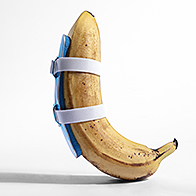The Horrible History of Broken Dicks

Sam Hughes, M.B., a junior surgeon at York Teaching Hospital in the U.K., wasn't expecting to make headlines this year when a patient came to see him in July after his junk "buckled" against his partner's perineum during sex. But upon further inspection, the vertical penile fracture is apparently the first of its kind in recorded history.
This grim-sounding injury is effectively a tear in the tunica albuginea, the erectile chamber's tough outer membrane—think less like bone and more like "cling film," or plastic wrap, as Hughes described it. When the tunica albuginea tears, typically due to sudden blunt trauma, like when a man accidentally thrusts into a partner's pubic bone, it's accompanied by a sinister "pop" or "crack" sound, as well as extreme pain and instant loss of erection.
In your typical penile fracture, the cling-film-like tunica albuginea tears horizontally around the circumference of the shaft. But with Hughes' case—as a hasty MRI revealed—the tunica albuginea fractured along the shaft in a vertical pattern.
Realizing the novelty of his patient's injury—a deep dive found no other record of such a fracture in the English language—the sufficiently intrigued surgeon documented his findings in a 2021 case report that instantly drew widespread attention beyond the medical community. It was a bit surprising given that "it doesn't make for good casual bedtime reading," Hughes said, having underestimated the public's taste for macabre medical horror.
In the weeks that have followed, nearly 100 media outlets around the world glommed on to this heinous tale, running enthusiastic headlines, the gist of them being: "Unlucky British Man Breaks [Dick, Willy, Schlong, Meat Stick, Trouser Snake, Pocket Rocket, One-Eyed Monster or Other Cheeky Word for Penis] Vertically, Makes Medical History."
While Hughes' patient's fracture was, by all accounts, the first recorded case of a vertical tear, there are more than a few examples of penis injuries that could make any reader wince.
Penile fractures over the ages
Presumably, as long as there have been erections (and overzealous sex), there have been busted boners. Medical personnel only began documenting these types of injuries around a thousand years ago, however, and to date, there is a mercifully low number of documented penile fractures (specifically, fewer than 2,000), many of which are illustrated by deeply unsettling images—you've been warned. Here's a timeline of noteworthy penile fractures over the ages.
1,000 A.D.: First known record of penile injury
The earliest mention of a penile fracture in medical literature appears at the end of the first millennium. Abul Kasim—a medieval Spanish surgeon born in 936 A.D.—penned instructions for a conservative (i.e., nonsurgical), yet bizarre, treatment for penile fractures, writing, "When a man's organ is fractured, take a goose's neck and introduce the penis into it; then let it be wrapped and bandaged and left for about 3 days until it be healed." Smart.
1934: Earliest English-language appearance
Penile fractures would go unmentioned in English-language medical literature until the early 20th century. Around that time, an article in The Journal of the American Medical Association describes a man who gets his penis "stuck in" a mattress and believes it "broke" because it "sounded like the breaking of a cornstalk."
1986–2000: Former pro basketball star breaks penis three times
One thing that is slightly reassuring about penile fractures: If you experience this rare injury in your lifetime, it's highly unlikely you'll ever break your dick again, according to a 2015 study in the Journal of Integrative Nephrology & Andrology. One noteworthy exception to this rule is Dennis Rodman, a retired NBA hall-of-famer, who broke his penis not once nor twice but on three separate occasions. Apparently, taking a running leap and trying to land your penis in a partner's vagina isn't as easy as shooting threes (which Rodman was also bad at).
2009: 'Grey's Anatomy' feature
Outside of the medical community and basketball fans, much of the world's penis-owning population remained blissfully unaware of the possibility of cracking their dick until January 22, 2009. On that date, an episode of "Grey's Anatomy" titled "Stairway to Heaven" first aired, featuring the hunky head of surgery, Mark "McSteamy" Sloan, suffering a penis fracture after illicit on-call room sex with earnest surgical resident Lexie Grey. Sloan's fictional fractured shaft sparked an explosion of frantic internet searches, pushing "can you break your penis" to the top of Google's most popular search terms by the next morning.
2018: 'Broken Bananah' is published
A penile fracture stars center stage in a 2018 memoir written by comedian Ross Asdourian. In "Broken Bananah," Asdourian tells the story of a hookup with a college pal in his Manhattan apartment that ends in catastrophe. As they near "the finish line," he describes hearing a "pop," followed by a fountain of blood spraying from the tip of his penis all over the walls. After prompt emergency care, Asdourian and his penis both survived to spread their harrowing tale to readers (and horrified morning show audiences) everywhere.
Common causes
Nearly 90 percent of penile fractures occur during intercourse, according to Andrew Siegel, M.D., a urologist serving as assistant clinical professor of surgery at the Rutgers-New Jersey Medical School. With that, he reports seeing only a couple of broken dick cases per year.
The position that puts you at the most risk of penile fracture is the reverse cowgirl ("Because of the angulation," Siegel said). Another risky position is rear-entry, or doggy-style, which a 2017 study published in the International Journal of Impotence Research identified as the most dangerous position when it comes to predicting penile injury.
Beyond specific positions, some research suggests certain stressful, out-of-the-ordinary situations may increase the risk of penile fracture. In a 2011 study published in the National Library of Medicine, study authors linked increased risk of penile fractures with extramarital affairs and sex in unusual locations, such as cars, elevators, public restrooms and the workplace.
Not all penises are broken accidentally. In some Middle Eastern countries, penile fractures are especially common due to a practice known as taqaandan, Kurdish for "to click." When performing taqaandan, men "crack" their penis by grabbing the shaft of their erect penis and bending the top to achieve detumescence. One 2000 study in the National Library of Medicine reviewed penile fractures in Kermanshah, Iran, between 1990 and 1999, and found that about 40 percent of study participants reported performing taqaandan out of habit, while a smaller percentage did it to overcome an erection or unwelcome sexual desires.
Seeking treatment
Some urologists posit that this condition is commonly missed and underreported, as many patients might not seek treatment out of embarrassment. But both Hughes and Siegel stress the importance of seeking medical attention immediately if you think you might have a fracture. Without immediate surgical repair, Siegel warned, you face long-term consequences, such as erectile dysfunction, an angulated penis and Peyronie's disease—which occurs when fibrous scar tissue develops on the penis, causing curved, painful erections.
Fortunately, a broken penis can often be mended within a single trip to the emergency room, Siegel said, followed by slow healing over the next couple of weeks.
So what happened to the patient with the well-publicized vertical penile fracture? Within four or so months of the injury, the patient was able to resume normal sexual activity. "His erections are back to the same quality that they were pre-injury," Hughes said. "He was very happy."




















